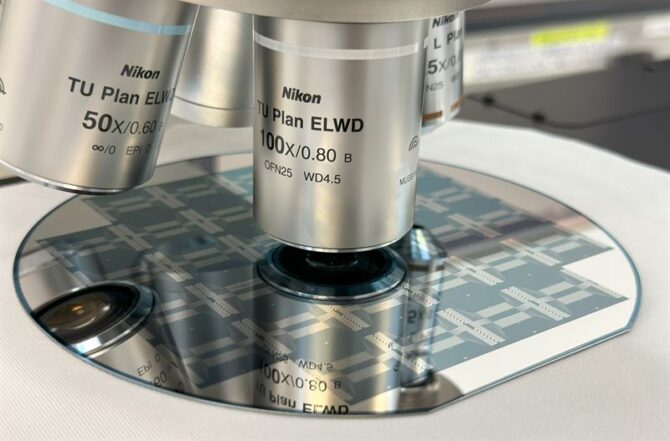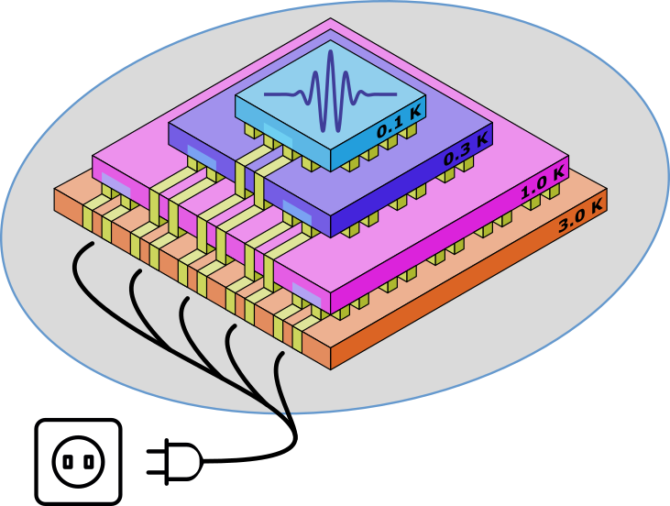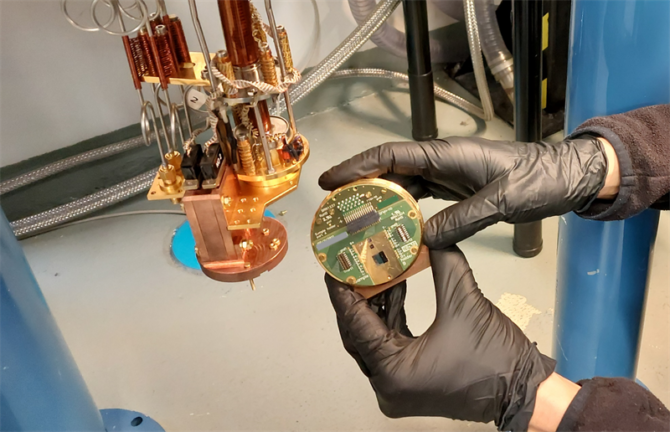
Cooling method will enable size reduction of quantum computers
EP&T Magazine
Electronics Thermal management Engineering cooling VTTVTT developing purely electrical cooling method
VTT Technical Research Centre of Findland is developing a cooling technology based on microelectronics and electric current, which can be utilised by low-temperature electronic and photonic components. The new technology reduces the size, power consumption and price of cooling systems. The method has a wide range of application fields: one topical example is quantum technology.

Figure 1: Silicon wafer with VTT’s electronic refrigerators. The wafer is under visual investigation under a microscope. Source: VTT
Many electronic, photonic and quantum technology components require cryogenics, as they only operate at very low temperatures. For example, a quantum computer built from superconducting circuits has to be cooled near to the absolute zero (-273.15 ℃). Currently, such temperatures are achieved by complex and large dilution coolers. VTT’s electronic method can replace and complement existing solutions and thus reduce the size of the refrigerators. Accordingly, this makes it possible to significantly reduce the size of quantum computers.
Electronic method as a part of the cooling system
Current dilution refrigerators are based on multistage pumping of cryogenic liquids. Although these coolers are commercial technology today, they are still very expensive and large. What makes the cooler technology complicated is especially its coldest stage, where refrigerant is a mixture of helium isotopes. New electric cooling technology could replace this part. This would make the system much simpler, smaller, more efficient and more cost effective. A cooler the size of a car, which cools a silicon chip of about a square centimeter in size, could be shrunk by orders of magnitudes down to a size of a suitcase, for example.

Figure 2: Schematic illustration of VTT’s electronic refrigerator technology. Refrigerator chips are joined by tunnel junctions, through which the passing electrical current leads to cooling, and the lowest temperature is reached on the topmost chip. Source: VTT
“We believe that this purely electric cooling method can be utilised in numerous applications requiring cryogenics, from quantum computing to sensitive radiation detectors and space technology,” says VTT Research Professor Mika Prunnila, who is leading the cooler development.
New business opportunities
VTT researchers have already experimentally confirmed the functionality of the cooling method. The method is now being refined into a commercial demonstrator in SoCool-project which was granted to VTT in the highly competitive EIC-Transition program of the European Commission. VTT will also continue the highly important fundamental research of electronic coolers in the CoRE-Cryo-project, funded by the Technology Industries of Finland Centennial Foundation.
Electric cooling can be used to actively cool components directly on a silicon chip or in large-scale general purpose refrigerators. It is a platform technology that is suitable for numerous applications and creates opportunities for new business. The active part of the cooler is manufactured using microelectronics manufacturing methods on silicon wafers, which makes the manufacturing very cost-effective.

Figure 3: VTT’s electronic refrigerator prototypes going to cryogenic testing. Source: VTT
“Making the refrigeration systems more user friendly, smaller and cheaper can significantly boost the application of cryo-enabled technologies to new areas. We see that our electronic cooling technology can play an important role in this development,” Mika Prunnila says.
Cryogenics has become an area of increasing interest thanks to quantum technology. Systems developed for the extreme demands of the quantum technology can be also used in various sensors, space technology and possibly also in classical computing. Compact and easy-to-use cooling methods contribute to the large-scale adoption of these technologies. Quantum technology is expected to be only the tip of the iceberg for cryogenic, cryo-electronic and cryo-photonic applications.
